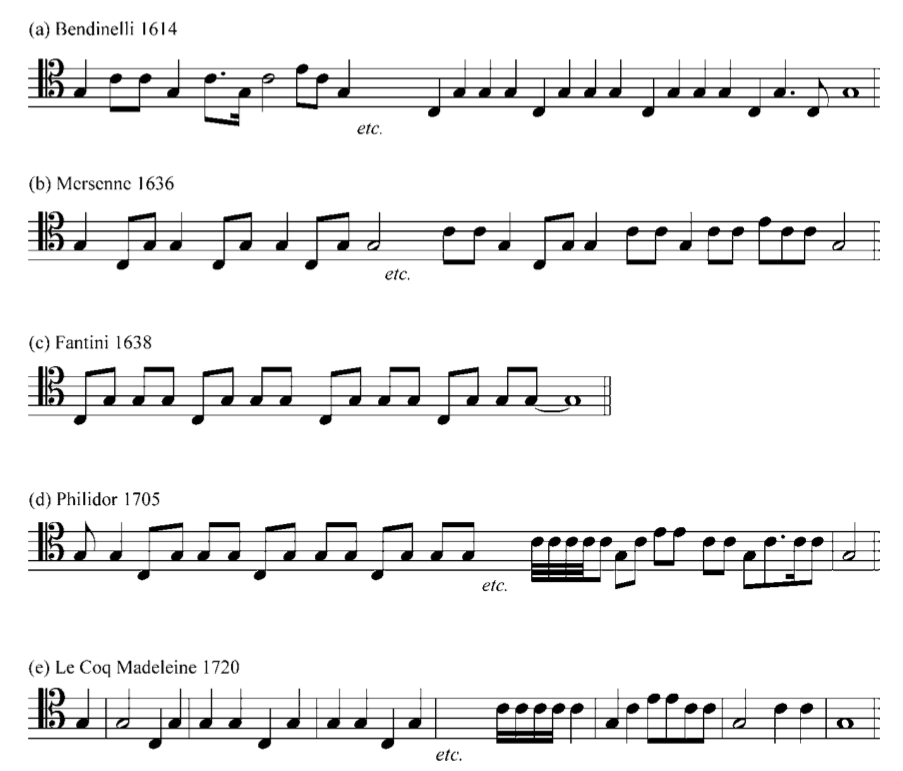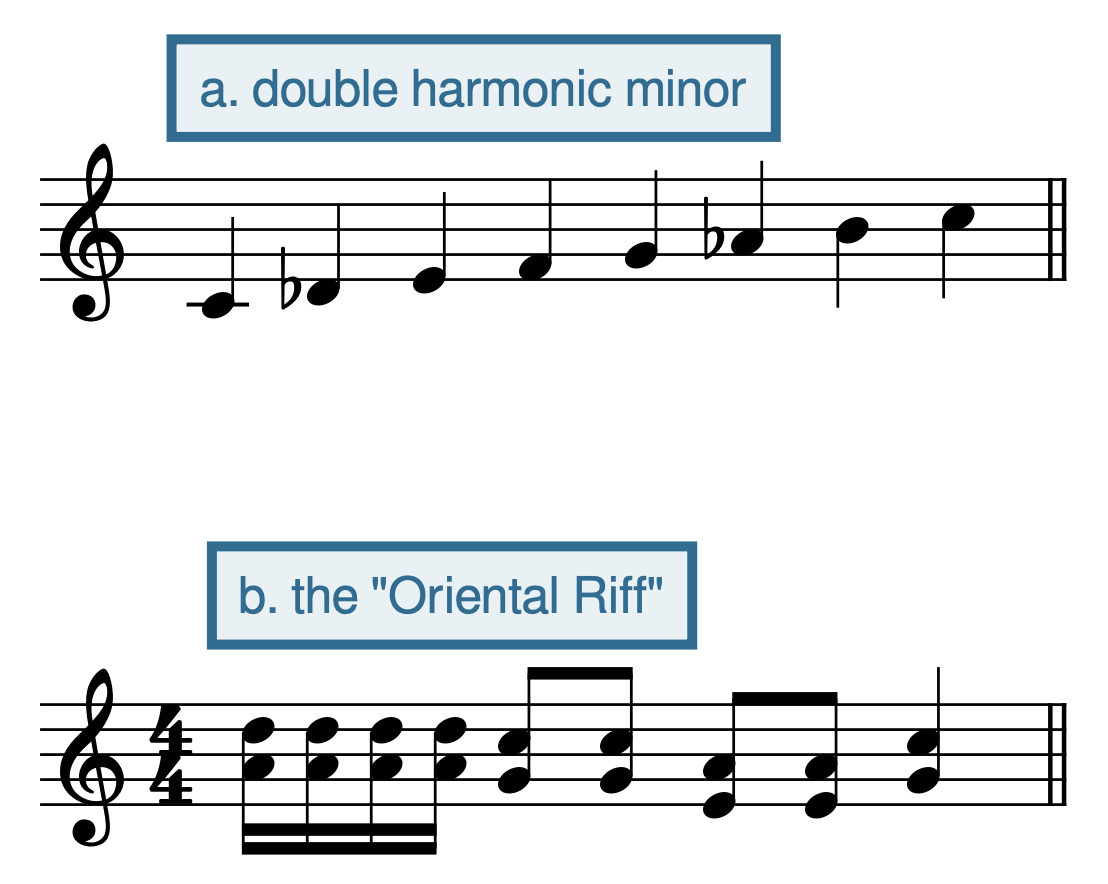Topics

Table of Contents
- The Military Topic
- Summary of semiotics
- Topics in Film Music
- Location-based Video Game Music Topics
- Exoticism and Colonialism in Film and Video Game Music
- Bibliography
- Assignments
Key Takeaways
- Musical topics are closely related to musical styles/genres. A style/genre becomes a topic when it is used in another context, alongside other styles/genres/topics, in order to evoke the various associations with that style.
- An example of a musical topic is the military topic, which may feature dotted rhythms, fanfare trumpets, and duple or quadruple meter. Darth Vader’s theme, “The Imperial March,” invokes the martial topic.
- Musical topics are commonly used to analyze Classical-era music but have also been fruitfully applied to film and video game music (VGM).
- A list of traditional Classical-era topics would include military, pastoral, hunt, Sturm und Drang, and others; for film and video game music, we might identify additional topics of magic, outer space, underwater, soaring, and so on.
Topic theory in music is based on the idea that listeners can recognize various styles of music and associate them with other situations even when they are appearing in a new context. This is a very fruitful approach to analyzing film and video game music (VGM), but the concept was originally developed to address Classical music.
Topic theory is often easy to grasp intuitively, so we’ll begin by discussing a Classical topic that we will also find commonly in film and VGM; then, a brief overview of semiotics will explain the philosophy behind topic theory; finally, we’ll briefly list some additional well-established topics that appear in film and VGM and give some examples of topic analysis.
The Military Topic
The military topic can be invoked through any combination of a number of musical features, listed below:
- Snare drum
- Brass instruments, especially the trumpet
- Dotted rhythms and/or triplet rhythms
- Melodies based on fanfares and field signals
- Janissary/”Turkish” instrumentation, including oboes, trumpets, and most importantly, heavy percussion including metallic instruments
- The march style, which itself is characterized by
- duple or quadruple meter
- wind instruments and percussion
- moderate tempo
The military topic in music of course may support militaristic themes such as warfare and soldiers, but it can also represent chivalry, a general warrior mentality, or heroism.
Many of these features are based on the characteristics of historical field signals used to communicate with troops in eras before radio (Example 1). Thorough explanations for how these characteristics came to represent the military topic can be found in Monelle (2006).

The military topic is reliably found in victory music. Chrono Trigger (1994) has three separate victory fanfares that players hear after winning a battle. Listen for the commonalities between them all: prominent trumpets and snare drum, triplet rhythms, quadruple meter, and moderate tempo. These features are clearly signifying the military topic.
Summary of semiotics
The idea of topic analysis is grounded in the philosophy of semiotics. This is a broad topic with a lot of nuance and different perspectives. The following summary should suffice as an introduction to the concept and the way it supports topic theory. Semiotics is concerned with the sign, which underlie much of how we think and communicate.
A sign in semiotics is anything that carries meaning. It might be a literal, physical sign, like a stop sign, but it’s not necessarily image-based—musical topics are signs that are aural signs. A stop sign means to stop your car; the military topic means heroism, conquest, and so on.
The sign is made up of two conceptual parts: the signifier and the signified. The signifier is the representation of the thing, while the signified is the thing being represented.
Signs might be very literal and logical or they can be defined by social conventions.
- Having a fever is a sign that a person is sick. The fever is the signifier; the illness is the signified. The signifier in this case is a natural consequence of the signified and their relationship is quite literal and objective.
- A stop sign means to stop your car. The red octagon and the word ‘stop’ forms the signifier; the action of stopping your car is the signified. This relationship is not logical or natural, but is instead a conventional meaning that society agrees upon.
Music can likewise signify in varying degrees of abstract or literal representation. A trumpet making a horse whinny sound effect is more literal than the conventions of the military topic defined above, but both are examples of musical signs.
Topics in Film Music
Following is a list of many common topics found in film music (Example 2). This list is by no means exhaustive! You can probably think of more topics yourself.
| topic | musical features | example |
|---|---|---|
| Military | brass instruments, especially trumpet; percussion, especially snare drum; melodies based on fanfares and field signals; duple/quadruple meter; moderate tempo | Final Fantasy victory fanfare |
| Flying | rapid, repetitive high-range gestures; rising arpeggiations; large leaps upward; instrumentation of strings, woodwinds, and harp | "Flying Theme" from E.T.: The Extra Terrestrial (1982) |
| Ominous Chant | use of Latin or Latin-sounding syllables; choir; heavy reverb | Battle scene from Chronicles of Narnia: The Lion, The Witch, and the Wardrobe (2005) |
| Epic | large performing forces (orchestra, choir, etc.), fast/heavy percussion, major chords, dissonance, melody in the brass | Batman: The Dark Knight Rises theme (2012) |
| Pastoral | Woodwind instruments, strings, compound meter, slow-to-moderate tempo, drones, simple/folk-like melodies and harmonies | The Legend of Zelda: Wind Waker, "Korok Festival" (2003) |
| Wonder | Triadic but highly chromatic harmony, frequent modulations, unstable sense of tonic, major chords, lydian ♯4 | Universal Studios opening fanfare (1990–1997) |
| Mystic/Magic/Gothic | celeste, female vocals, recorder, minor mode, chromaticism | Main theme from Edward Scissorhands (1990) |
Again, there are far more possible topics to discuss; an exhaustive list would be impractically large. The website TV Tropes has a list of musical tropes that in many cases can also function as musical topics, if you would like to get a sense of the breadth of these phenomena.
Location-based Video Game Music Topics
Video game music and film music share many topics, but video game music topics are often tied specifically to the location/biome in which the action is taking place in a way that is less common for film music. Following is a list of common video game locations and their associated musical features.
| topic | musical features | example |
|---|---|---|
| Air/flying | ascending melodies; large ascending leaps; strings, harps, winds; motor rhythm, consistent rhythm; | FFVII Airship Theme) |
| Beach | steel pan, xylophone, marimba; ukulele/guitar-family instruments; simple harmonies; hand drums; shaker; | "On the Beach" from Yoshi's Story (1997) |
| Cave | lower-activity; heavy reverb; minor; marimba, xylophone; thinner texture; low-range instruments; low-pitched percussion; chromaticism; | "Cavern on the Lake" from Pokemon Diamond |
| Factory | heavy percussion, especially high-range; syncopation; high rhythmic activity, ostinati; active bass line; tinks, clanks; modern/industrial/urban styles; | "Chemical Plant Zone" from Sonic the Hedgehog 2 |
| Field (travel/world map) | woodwind/string runs; snare drums; motor rhythm; galloping rhythms, military rhythms; major; fanfare, antiphony; | "Hyrule Field Main Theme" from Legend of Zelda: Ocarina of Time (1998) |
| Forest | woodwinds (especially flutes); strings; wooden instruments (marimba, xylo); high and low frequency, but not much middle; sustained notes, pedal tones; heavy reverb; minorish, dorian; | "Ymir Forest" from Tales of Symphonia (2004) |
| Lava | quasi-Indian-classical: sitar, tabla, tambura; low-pitched percussion; marimba; gamelan-esque sounds; generally south Asian (hot countries) timbres | "Lethal Lava Land" from Super Mario 64 (1996) |
| Town | hand drums; tambourine; woodwinds, strings; major mode; lilting rhythms; all pastoral things; moderate or slow tempo | "Welcome to Our Town!" from Final Fantasy IV (1991) |
| Winter | sleigh bells; all metallic percussion, marimba/xylo; glockenspiel, glass harmonica, celeste; heavy reverb; no drums; high woodwinds, strings; arpeggiation; - plucked strings | "Shiver Star" from Kirby 64: The Crystal Shards (2000) |
Exoticism and Colonialism in Film and Video Game Music
Topic analysis of film music often relies on genres of music, but not all genres of film or video game music seem to be equally suggestive of musical topics. The norm for film music is a Western classical (small-‘c’) tonal idiom, so if we hear bowed strings playing tonal music, like this theme from Pig (2021), we may not make any particular topical associations.
Other ensembles or other music traditions besides tonal orchestral music can readily suggest a specific musical topic. While using another musical culture can be useful for evoking a setting or a character, using music from a marginalized culture as a musical topic can feel tokenizing if not done carefully. For example, using the double-harmonic minor scale to signify Middle-Easternness or Jewishness (Example 3a), using the “oriental riff” to signify Asianness (Example 3b), or using generic drumming to signify Africanness the flattens the nuances of the music cultures from that region. These musical topics often have their roots not in the authentic music of those regions, but in 19th- or early-20th-century Western entertainment like vaudeville and minstrel shows. While a modern composer may know better than to use the “oriental riff,” similar problems can arise when composing using DAWs, virtual instruments, and sample packs marketed as representing various countries.

As composers, music analysts, performers, and even consumers of media, it is important to be aware of these issues and how they shape our perceptions of unfamiliar cultures. Many scholars have critiqued topic theory for contributing to essentialism and colonialism. When using topic theory to analyze a soundtrack, keep these issues in mind and be sensitive to them.
Bibliography
- Lehman, Frank. 2018. “Introduction.” In Hollywood Harmony: Musical Wonder and the Sound of Cinema, 1–14. New York, NY: Oxford University Press.
- Monelle, Raymond. 2006. The Musical Topic: Hunt, Military and Pastoral. Bloomington: Indiana University Press.
- Elferen, Isabella van. 2013. “Fantasy Music: Epic Soundtracks, Magical Instruments, Musical Metaphysics.” Journal of the Fantastic in the Arts 24 (1): 4–24.
- Atkinson, Sean E. 2019. “Soaring Through the Sky: Topics and Tropes in Video Game Music.” Music Theory Online 25 (2). https://doi.org/10.30535/mto.25.2.1.